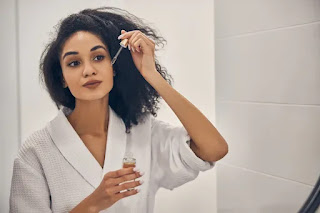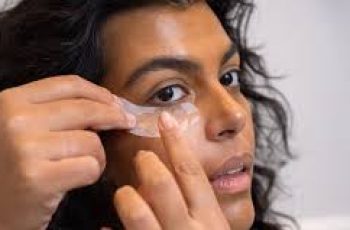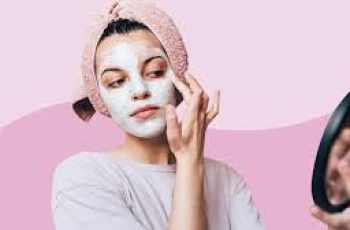
How to Tighten Sagging Facial Skin?
Interestingly, sagging skin becomes noticeable once you accept the fine lines and wrinkles that form on your skin over time. However, when it comes to sagging skin, there is often a lot of confusion about which routine or treatment is best to combat and potentially reverse the signs of sagging skin. So today I will focus on learning more and sharing with you the best tips I have found, as well as answering your questions about how to tighten sagging facial skin.
But before that, let’s first find out why this is happening:
Why does my facial skin sag?
First, the production of collagen and elastin in the skin decreases. As we age, this process slows down, causing the skin to show signs of sagging, often starting with the jawline and cheeks, commonly referred to as the “jowls.”
UV radiation is the leading cause of sagging skin. Sunlight free radical damage not only breaks down existing collagen by activating enzymes, but it also prevents new collagen from forming, causing the skin to lose firmness overall.
You may also have noticed that we often lose facial fat as we age, which over time can cause the face to look dull and sagging.
Lack of daily skin care can also cause your skin to age much faster than expected. Even a simple routine can help slow down the signs of aging.
Lifestyle also plays a role in skin aging. Habits such as smoking, excessive drinking or using tanning beds can cause your skin to age faster.
Now that you have a better understanding of how your skin starts to sag and what the causes are, I will now give you some advice on how to treat and prevent sagging skin at home and with the help of a trained professional.
How to Tighten Loose Skin on Your Face?
There are several ways to tighten sagging skin. First, let me share with you the simplest method, which has gained a lot of popularity over the past few months, which is daily facial massages. These massages are designed to train the facial muscles under the skin. Although we use them all the time to speak and express thousands of different expressions, we rarely train them in a way that tightens and firms the skin. You can find many different tools and different techniques on social media and YouTube. If you decide to try facial massage, it is best to use it regularly for more than two weeks to see results. This gives you enough time to see noticeable improvements.
Another way to tighten sagging facial skin is to try popular skin treatments such as radiofrequency and ultrasound devices. Both methods produce impressive results by boosting collagen production while minimizing discomfort and providing a super-fast recovery time. Possible side effects after treatment are redness, swelling, and some numbness, but these will subside quickly. Keep this in mind if you are considering cosmetic surgery to combat sagging skin. Many doctors say they recommend surgery as a last resort over the two treatments mentioned above.
Can sagging facial skin be reversed?
Yes, you can! When it comes to aging skin, we believe that preventive measures play a vital role. It is never too late to start using skincare products or specific ingredients and methods. Once you use one of these, you will notice a significant improvement in the overall appearance of your skin’s appearance and complexion. By introducing powerful active skin ingredients or starting to use a massager, you have taken the first step to reversing sagging skin, especially around the chin and cheek areas.
Here are some changes you can make if you want to prevent sagging skin:
Applying a sunscreen of SPF 30 or higher every day, even on cloudy days, will protect your skin from harmful free radical damage and collagen breakdown.
Avoid smoking and tanning beds.
Drink enough water during the day.
Make sure to cleanse your skin thoroughly at the end of the day to remove makeup residue.
Use a skincare routine with powerful ingredients.
You can also reverse sagging skin with the skincare tips we’ve already shared. Don’t forget, you can learn more about fighting signs of aging in our blog post on the 5 most effective anti-aging ingredients.
How to increase collagen levels on your face?
There are many ways to increase collagen levels in your skin, which can be easily achieved through topical ingredients, supplements, and diet.
Hyaluronic acid – an important compound for collagen in the skin, found in various foods, dietary supplements, and many skincare products. It also has moisturizing properties, i.e. it locks in moisture in the skin, making the face look hydrated and youthful.
Vitamin C – a powerful antioxidant that fights free radicals and protects against skin damage caused by UV radiation, pollution, central heating, and other environmental influences. Retinol – praised for its ability to extend the life of collagen in the skin, and it blocks enzymes that create free radicals and break down collagen. To ensure these powerful ingredients work their best, it’s best to opt for a serum formula. This is because, unlike a moisturizer, a serum can penetrate deeper into the lower layers of the skin and reach the areas where collagen is produced. I hope today we’ve found some answers to your concerns about sagging skin. Don’t forget, you can always check out our Instagram for more skincare tips, new product launches, and weekly giveaways.
DQH Can I use salicylic acid first and then vitamin C?
It’s easy to create a skincare routine, but knowing how to use it is another thing entirely. In most cases, if you’re not getting the desired skin results, it could be due to the layering of conflicting ingredients. So, is it possible that salicylic acid and vitamin C are such ingredients? Or are these active ingredients the duo that’s been missing from your skincare routine? If you want answers, stick around because today we are going to explain the benefits of salicylic acid and vitamin C and how they can be used in your daily life.
What are the benefits of salicylic acid for skin?
Salicylic acid is one of the most commonly used beta hydroxy acids and is favored by many people with oily, acne-prone skin. This acid is derived from willow bark, and unlike its water-soluble relatives (called alpha-hydroxy acids), salicylic acid is oil-soluble, which means it can penetrate deeper into the lower layers of the skin. Once it reaches the lower layers, it can help unclog pores of excess sebum, dirt, bacteria, debris, and impurities. This results in clearer skin tones and greater definition.
Not only does salicylic acid benefit the underlying layers, but the outer surface of the skin benefits as well. When applied to the skin, salicylic acid removes the buildup of dead skin cells. This is accomplished by breaking the bonds that hold dead cells to the surface. Over time, this can cause the complexion to look dull and prone to acne, blackheads, and other blemishes.
If you’d like to learn more about salicylic acid and how it can improve your skin, check out this dedicated blog post from a beauty insider.
What are the benefits of vitamin C for skin?
Vitamin C is considered one of the most powerful antioxidants, which means it is very effective at fighting free radicals and preventing them from causing further skin damage. Examples of free radicals include pollution, central heating, UV rays and harsh climate. They attack proteins, fats and cell membranes as soon as they come into contact with the skin, causing signs of premature aging such as fine lines and wrinkles as well as hyperpigmentation, flaky patches of skin and loss of elasticity.
Many people usually prefer to use vitamin C in their morning routine as this ingredient gives the complexion a radiant glow. You’ll also find that vitamin C can target areas of hyperpigmentation, plumping the skin and reducing the appearance of fine lines and wrinkles.
The thing about vitamin C is that there are a lot of outdated studies going back to the 1950s that describe vitamin C as an unstable skin component. Thanks to improvements in modern technology, this is no longer the case as all products now contain a stable form of vitamin C.
Visit The Beauty Insider to learn more about vitamin C. So please check out our blog post.
Can I use salicylic acid first and then vitamin C?
Yes, you absolutely can. In fact, it’s thought that using salicylic acid before using vitamin C ensures it penetrates faster and works faster.
This is an efficient way to utilize two power sources, and the reason has to do with pH. For example, the skin’s natural pH is about 4.7, making it slightly acidic. Salicylic acid and vitamin C are also both acidic, and you’ll find that vitamin C is absorbed quickly into the skin. Therefore, using salicylic acid beforehand can increase the acidity of the skin and allow vitamin C to penetrate into the skin faster.
While this is considered an effective way to combine two powerful ingredients, you need to be aware of your skin type and how it reacts to certain active ingredients. Even people with perfect, normal skin can experience skin sensitivity and irritation. Therefore, always consult a doctor or dermatologist before using any new products on your skin.
It’s also important to follow skin application rules. In this case, you need to use the product correctly to ensure you get the best results for your skin. If you’re not sure what I mean, the basic rule for skin is to start with the thinnest consistency and work your way up to the thickest consistency. This prevents a barrier from forming on the surface, preventing other active ingredients from penetrating the skin.
Can I use salicylic acid at night and vitamin C in the morning?
Yes, absolutely, this is considered the most effective way to get returns without any adverse side effects. This is because there is enough time between applications to ensure that the skin’s pH levels return to balance.
You’ll also find that Vitamin C is rich in antioxidants and is perfect for use in the morning to ensure your skin is protected and looking its healthiest. Due to the small size of salicylic acid molecules, it is an acid that is able to reach the deepest parts of the skin. While this is effective at keeping skin clear, it also increases the risk of irritation and photosensitivity. Therefore, many people prefer to use powerful BHAs in their evening routine without exposure to UV rays, pollution, or harsh weather.
Warning: If you avoid using sunscreen every day, none of these ingredients will do what your skin needs. The combination of chemical peels and powerful ingredients increases the risk of further damage to the skin’s surface. Use SPF 50 every day to keep your skin protected and your lipid barrier healthy, even on cloudy days, keeping your skin in top condition.


